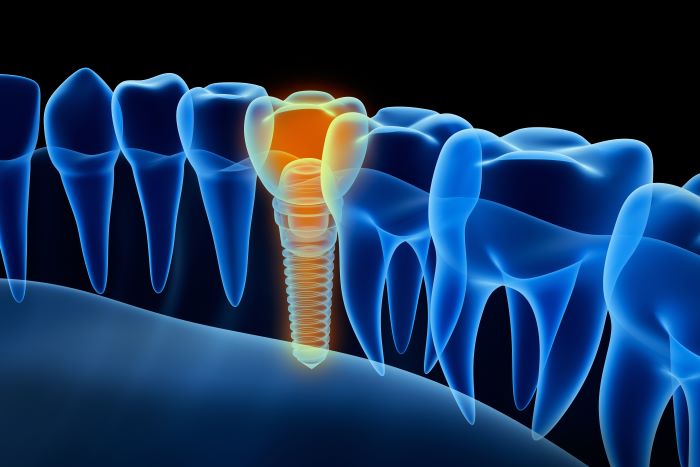History of Dental Implants

Nowadays, if you lose a tooth then often you will be suitable for dental implants. Dental implant technology is frequently regarded as the very best way to restore one or more missing teeth, and it’s a solution that is long-lasting and durable.
The need to have a nice and complete smile might seem like a modern idea, but in fact, it dates back thousands of years. People have always lost teeth, perhaps because of infection or decay or due to trauma, and over the years have tried all sorts of different techniques to replace them.
The Earliest Form of Dental Implants
The earliest versions of dental implants date back to about 2000 BC when people in ancient China were using carved bamboo pegs to restore their missing teeth. Modern dental implants are usually made from metal, and the first recorded case of an ancient dental implant was found in an Egyptian King who was alive approximately 1000 BC. Archaeologists discovered that his upper jawbone had a copper peg hammered into it but are unsure whether it was used as a replacement tooth while he was alive or if it was placed after death.
In France, archaeologists found a Celtic grave where its occupant had a false tooth made from iron, believed to have dated back to approximately 300 BC. However, due to the potential pain of inserting this tooth, it’s thought this early implant was hammered into place after death. Around approximately the same time, the Phoenicians were using gold wire to stabilize teeth, and they were also creating new teeth carved from ivory. In Mayan civilization, people used pieces of shell as dental implants, and radiographs taken in the 1970s show new bone formation around these implants that look remarkably like the earliest modern dental implants.
Throughout ancient history, there are lots of cases where missing teeth were replaced with animal teeth or even with teeth from other humans. The possible risk for infection and ultimate rejection of these first dental implants is unpleasant to consider, not to mention the pain that recipients must have experienced. It took several centuries before significant developments into the techniques used to manufacture and place dental implants were made.
16th and 17th-Century Dental Implants
By the early 16th century, people were collecting teeth from cadavers or from live donors and which were transplanted into people missing their own teeth. During this time dentists learned a lot from resurrectionists who acquired cadavers by digging up graves. Dr. John Hunter began experimenting with transplanting teeth from one human to another. His initial experiment involved implanting a developed tooth into a rooster comb. He noticed the tooth became embedded in the comb of the rooster and the blood vessels grew from the rooster straight into the tooth pulp.
18th and 19th-Century Dental Implants
By the 18th century, some dentists had begun to experiment using gold alloys to make artificial replacement teeth, but ultimately these weren’t very successful. In 1886, one dentist tried mounting a porcelain crown onto a disc of platinum, which again wasn’t a success in the longer term. Not surprisingly, one of the main problems faced by these dental practitioners was rejection. The dental implant was simply rejected as a foreign body. Now, thanks to modern dental implant techniques, we know that a dental implant must fuse with the jawbone to be successful, a process that is known as osseointegration.
20th-Century Dental Implant Techniques
It wasn’t until the 20th century that an orthopedic surgeon discovered the right metal to enable osseointegration. During the study into bone healing, the surgeon discovered that a cylinder made from titanium had successfully fused with the femur bone of a rabbit. He quickly realized the implications for dental implants. In 1965 the very first titanium dental implants were placed in a human by an orthopedic surgeon called Branemark. The dental implant surgery was a success, and the volunteer enjoyed the implant teeth for some 40 years after.
Following this initial success, dental implant technology quickly evolved, and surgeons began to use a titanium alloy screw that was surgically inserted into the jaw. Usually, the screw surface was roughened to encourage the process of osseointegration, a technique that is still used today. Once healed, the implant screw was firmly fused to the jawbone allowing a new implant crown to be attached to the screw.
Modern Dental Implant Technology
Nowadays, dental implant surfaces are frequently mechanically or chemically treated to encourage new bone growth on and around the implant screw. Other dental implants have what’s called a hydroxyapatite coating which is a layer of calcium and phosphate that helps to create a strong bond between the implant and the jawbone. Some dental implants may even be metal-free and are fabricated from a bone-colored material called zirconia.
Zirconia or Ceramic Dental Implants
Also known as ceramic dental implants, they can be ideal for people who have metal sensitivities or who prefer a metal-free mouth. All-ceramic dental implants and restorations can also significantly improve the cosmetic outcome of treatment, and especially when restoring teeth right in the front of the mouth.
Restoring Complete Arches of Teeth
Another highly significant development in dental Implantology is the ability to restore complete arches of teeth which is ideal for people who currently wear full dentures or who are facing complete tooth loss. Instead of dentures, people can now have implant-supported dentures that have special fittings clipping onto dental implants, and which are removed each day for easy cleaning. This solution is quite cost-effective because relatively few dental implants are required. Sometimes only two dental implants are needed to support a lower arch denture, while an upper denture will usually require four or more dental implants because the bone is softer. Alternatively, it’s even possible to restore an entire arch of teeth with a fixed bridge that is permanently screwed or cemented onto the dental implants.
Dental implants also come in a wide variety of sizes, for example, mini dental implants are narrower than conventional dental implants, making them perfect for restoring smaller lower front teeth.
Perhaps one of the best things about modern dental implants is that treatment can be entirely pain-free using sedation dentistry here at Gentle Dental Arts. With this technique, even nervous patients can comfortably receive even the most complex dental implants, safe in the knowledge that implant treatment has an excellent success rate of 95% or more. Don’t hesitate to reach out to us today to find out more and schedule a consultation.










